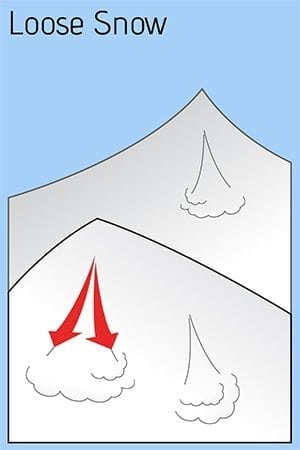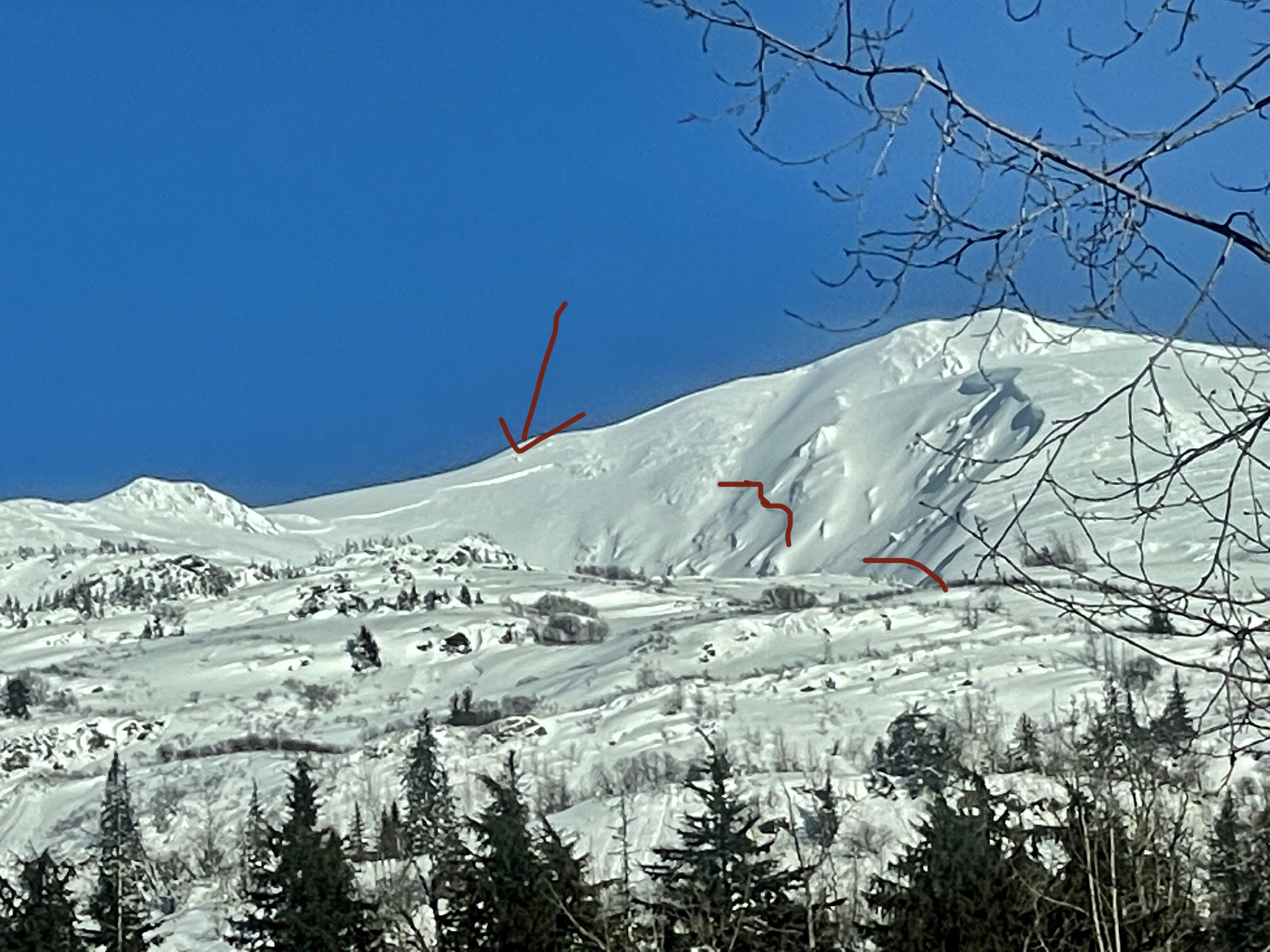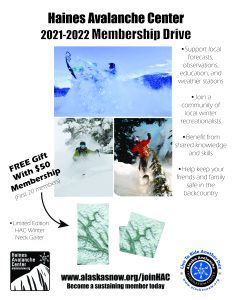Haines Avalanche Center
Above 2,500ftModerate
1,500 to 2,500ftLow
Below 1,500ftLow
Degrees of Avalanche Danger
Avalanche Problems
Problem 1
Aspect: All
Elevation: Above Tree Line
Bottom Line: As we transition into springtime, be aware that conditions within the snowpack can change rapidly. Last weekend produced 4-10” of snow over several days in the alpine. This week has beckoned in warmer days and colder nights which has created temperature fluctuations at the surface of the snowpack called diurnal recrystallization. As this process weakens the snow at the surface, it may be possible to trigger unconsolidated pockets of loose snow within the surface layer. At the point of the release the snow begins to gather speed and can pick up more snow as it moves downhill creating a fan shape. Do not underestimate loose snow avalanches, especially in areas of high consequence terrain. This weakened snow also has the potential to become a problematic layer after the next storm cycle delivers new snow.
Travel Advice:
- Avoid terrain traps where avalanche debris can concentrate.
- Avoid narrow areas, where it may be difficult to escape off to the side.
- Avoid exposure above cliffs where small avalanches can create greater consequences.
- Avoid being in the run out zone of steep terrain as the fan shape can spread out over a large area.
- Avoid long, sustained slopes as the potential for more snow to gather can increase the hazard.
Additional Consideration:
We believe deeper persistent layers are currently dormant. However, you could still trigger a persistent slab in thin or shallow snow even if we haven’t had recent feedback or avalanche activity. With the beginning of March comes a higher sun angle than we have seen for the last couple months. Surface warming will begin to be prevalent on solar days, especially around exposed rocks and creating thin and/or weak spots where you could trigger these deeper layers. Remember that persistent slabs are unpredictable and that tests and observations can be unreliable. A probe can be very helpful to determine snow depth and presence of deeper buried weak layers by noting resistance as the probe moves through the snow. Continue to use wide margins of safety, collect information and be patient when it comes to more committing terrain.
Likelihood:
- Almost Certain
- Very Likely
- Likely
- Possible
- Unlikely
Size:
- Historic
- Very Large
- Large
- Small
Trend
- Increasing
- Steady
- Decreasing
Avalanche Activity
From 1/29 to 2/1, several reports came in of recent avalanches in the alpine. The common characteristics of these slides were wide propagation, and failing 2-5ft deep at the interface below the wind slabs from last week’s atmospheric river. We have strong reason to suspect these slides occurred on a buried surface hoar layer from 1/20. They happened on all aspects, at elevations from 3000 – 5000ft, and all were in wind sheltered areas below ridges, features, and starting zones. Slide were observed in the Transitional and Lutak zones.
4Winds zone. SW. 4000-5000′
Near Mt. Kraus
The confluence of the Boundary and Saksaia glaciers above Glacier Creek. N. ~4700′
Weather
Forecast:
Quiet weather will blanket much of the area for the next day. Mostly cloudy with light W-NW winds and trace amounts of precipitation. Temperatures will reach near freezing by mid day. With mimcl amounts of wind, areas of patchy fog may be around through the morning, especially near the border.
Seasonal Summary:
- Feb 28th-March 2nd saw diurnal temperature swings.
- Feb 16-19th light snow 3-4″ with freezing levels reaching 1,500′ with strong south winds.
- Feb 12-14th had freeze/thaw cycles that locked up the snowpack to ~4,000′.
- Feb 5th-9th brought snow levels near 3,500ft, and 2.5-4″ of SWE with strong south winds.
- Feb 1st-4th brought in 12-24″ of low density powder.
- Jan 27-29 brought 1.5 – 2.4″ of SWE with freezing levels near 1500ft.
- An Atmospheric river hit Jan 21-22. It brought in 2-7″ of SWE (2-5ft of snow above 2500ft, mostly rain below)
- Jan 9th-15th brought 24-48″ of new snow in the alpine, with some light rain up to 3,500ft, followed by heavier rain up to 2000ft.
- Very strong NW winds and arctic temperatures blasted the area the first week of January.
- Jan 1st: New snow (20″ in Lutak, 7″ Transitional zone) buried any preserved surface hoar.
- Moderate NW winds hit exposed slopes Dec 19-20th.
- Surface hoar formed on all aspects and elevations Dec 17-18th.
- December brought in about 2-5 feet of snowfall (highest in Lutak zone), and a few strong NW wind events.
- November brought consistent heavy snowfalls, cold weather, and SE winds.
- October brought heavy snow in the alpine, followed by a few rain/sun crusts.
| Snow Depth [in] | Last 24-hr Snow/SWE [in] | Last 3-days Snow/SWE [in] | Today’s Freezing Level [ft] | Today’s Winds | Next 24-hr Snow/SWE | |
| Mount Ripinsky @ treeline ** | 125″* | 0″ / 0.0″* | 0” / 0.0″* | 1000′ | Light, W-NW | 0″ / 0.0* |
| Flower Mountain @ treeline | 75″ | 0″ /0.0″ | 0″ / 0.0″ | 300′ | Light, W-NW | 4″ / 0.0″ |
| Chilkat Pass @ 3,100ft | 37″ | 1” / 0.1” | 1” / 0.1” | 0′ | Light, W | 2″ / 0.2” |
( *star means meteorological estimate )
** The Ripinsky weather station is in need of repair, and will likely be down until Summer.
Additional Information
Safe backcountry travel requires training and experience. You control your own risk by choosing where, when and how you travel. Ride rescue ready. Be prepared for an emergency. Prevent hypothermia. Carry bear spray. Winter is a high consequence environment.
Become a sustaining Haines Avalanche Center Member by clicking the poster or visiting alaskasnow.org/joinHAC. Support local forecasts, observations, education and weather stations. Join a community of winter recreationalists. Benefit from collective knowledge and skills. Help keep your friends and family safe in the backcountry. Get a free limited edition mountain buff, or neck gaiter with a $50 membership (first 20 members!).
Practice like you play. Make sure all your rescue gear is fully functional and your beacon has NEW batteries. Make sure 1) everyone in the group has a functioning beacon, shovel and probe 2) knows how to use them and 3) has trained in companion rescue in the last year. Keep your skills fresh. If you head into the hills, watch out for red flag avalanche conditions, natural avalanches, whoomphing or collapsing, and shooting cracks.
Education Video Links:
- AIARE
- How to Practice Avalanche Rescue Snowmobile Edition: https://youtu.be/2ML499MMDfM
- AK Sled Shed Motorized Learning:
- Intro: https://youtu.be/aoagKHfGkxs
- Personal Electronics in Avalanche Terrain: https://youtu.be/2Vz9S0OEyFk
- Snowmobile Macgyver Tool Kit: https://youtu.be/4WBNu_t6Bbk
- Head and Face Protection: https://youtu.be/jIzW89wOyZI
- Pre-season prep: https://youtu.be/zJmrb8cZlR4
- My Transceiver: https://youtu.be/yblaDWP7Jf8
- BCA Avalanche Safety for Snowmobilers
- How to Fix Common Snowmobile Problems in the Field: https://youtu.be/g9fiTxEvuFk
- Sleducation: Avalanche Safety for Snowmobilers: https://youtu.be/EWFOd_9DYb8
- Intro to Avalanche Transceivers for Snowmobilers: https://youtu.be/6ZLSBmsceog
- Avalanche Transceiver Trailhead Test for Snowmobilers: https://youtu.be/rWoXbadFBsY
- Avalanche Transceiver Searching Use Snowmobiles: https://youtu.be/w1ucyI6LMXM
- BCA Avalanche Rescue Series
- Beacon Search 101: https://youtu.be/nnHXLVA2FcE
- Avalanche Probing 101: https://youtu.be/-0_yDN5Drzw
- Avalanche Shoveling 101: https://youtu.be/dGQg9o3vAkM
- Organizing a Backcountry Rescue: https://youtu.be/gywtmukgt8s
- Post Avalanche Patient Care: https://youtu.be/9FyIeUy4wpQ
- Backcountry Evacuation: https://youtu.be/WPF-dciefL8
- Complex Multiple Burials Backup Techniques: https://youtu.be/pB6AfY2KyYo
- National Avalanche Center
- Avalanche Problems Explained: https://youtu.be/DkbnT_9-cHU
- Intro to North American Avalanche Danger Scale: https://youtu.be/r_-KpOu7tbA
Announcements
Click the +Full Forecast button below to read the details. Please submit your observations if you head out!




